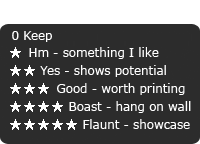Seeing stars
 Just writing something (for book 7) on the use of star ratings. A great way to develop consistency is by defining what your star ratings actually signify. This varies depending on what type of photographer you are, so for example a studio photographer might define 5 stars as what is good enough for the studio walls, while a stock photographer might see ratings in terms of saleability.
Just writing something (for book 7) on the use of star ratings. A great way to develop consistency is by defining what your star ratings actually signify. This varies depending on what type of photographer you are, so for example a studio photographer might define 5 stars as what is good enough for the studio walls, while a stock photographer might see ratings in terms of saleability.
If you have such a mental definition, maybe write it down too – just sticking a post-it note on the screen’s side may help.
Alternatively, Lightroom’s panel end decorations, so frequently derided as a waste of programming time can, with a tiny bit of imagination, actually be made to serve more than a trivial decorative purpose.